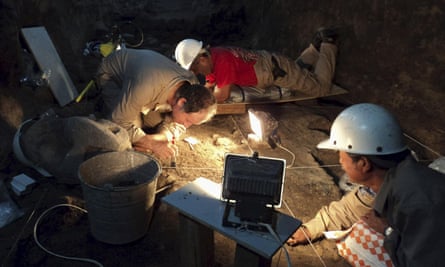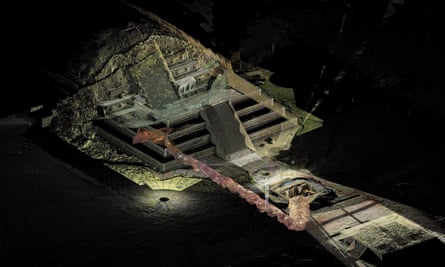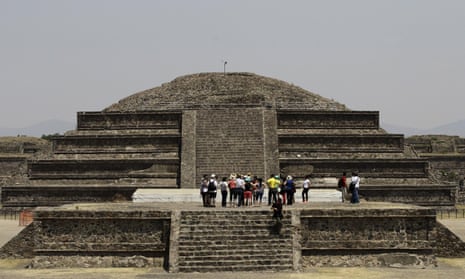An archaeologist has discovered liquid mercury at the end of a tunnel beneath a Mexican pyramid, a finding that could suggest the existence of a king’s tomb or a ritual chamber far below one of the most ancient cities of the Americas.
Mexican researcher Sergio Gómez announced on Friday that he had discovered “large quantities” of liquid mercury in a chamber below the Pyramid of the Feathered Serpent, the third largest pyramid of Teotihuacan, the ruined city in central Mexico.
Gómez has spent six years slowly excavating the tunnel, which was unsealed in 2003 after 1,800 years. Last November, Gómez and a team announced they had found three chambers at the tunnel’s 300ft end, almost 60ft below the temple. Near the entrance of the chambers, they found a trove of strange artifacts: jade statues, jaguar remains, a box filled with carved shells and rubber balls.

Slowly working their way down the broad, dark and deep corridor beneath the pyramid, battling humidity and now obliged to wear protective gear against the dangers of mercury poisoning, Gómez and his team are meticulously exploring the three chambers.
Mercury is toxic and capable of devastating the human body through prolonged exposure; the liquid metal had no apparent practical purpose for ancient Mesoamericans. But it has been discovered at other sites. Rosemary Joyce, a professor of anthropology at the University of California, Berkeley, said that archaeologists have found mercury at three other sites around Central America.
Gómez speculated that the mercury could be a sign that his team is close to uncovering the first royal tomb ever found in Teotihuacan after decades of excavation – and centuries of mystery surrounding the leadership of the cryptic but well-preserved city.
The mercury may have symbolized an underworld river or lake, Gómez postulated, an idea that resonated with Annabeth Headreck, a professor at the University of Denver and the author of works on Teotihuacan and Mesoamerican art.
The shimmering, reflective qualities of liquid mercury may have resembled “an underworld river, not that different from the river Styx,” Headrick said, “if only in the concept that it’s the entrance to the supernatural world and the entrance to the underworld.”
“Mirrors were considered a way to look into the supernatural world, they were a way to divine what might happen in the future,” she said. “It could be a sort of river, albeit a pretty spectacular one.”
Joyce said that archaeologists know that scintillation fascinated the ancient people generally, and that the liquid mercury may have been regarded as “somewhat magical … there for ritual purposes or symbolic purposes.”
Headrick said that mercury was not the only object of fascination: “a lot of ritual objects were made reflective with mica,” a sparkling mineral likely imported to the region.
In 2013 archaeologists using a robot found metallic spheres which they dubbed “disco balls” in an un-excavated portion of the tunnel, near pyrite mirrors. “I wish I could understand all the things these guys are finding down there,” Headrick said, “but it’s unique and that’s why it’s hard.”
Water was also precious to many of the people of Mesoamerica, who knew of underground water systems and lakes that could be accessed through caves. Teotihuacan once had springs as well, though they are now dried out.
Joyce said the ancient Mesoamericans could produce liquid mercury by heating mercury ore, known as cinnabar, which they also used for its blood-red pigment. The Maya used cinnabar to decorate jade objects and color the bodies of their royalty, for instance; the people of Teotihuacan – for whom archaeologists have not agreed on a name – have not left any obvious royal remains for study.

The discovery of a tomb could help solve the enigma of how Teotihuacan was ruled, and Joyce said that the concentration of artifacts outside the tunnel chambers could be associated with a tomb – or a set of ritual chambers.
A royal tomb could lend credence to the theory that the city, which flourished between 100-700AD, was ruled by dynasties in the manner of the Maya, though with far less obvious flair for self-glorification.
But a royal tomb could also hold the remains of a lord, which may fit with a competing idea about the city. Linda Manzanilla, a Mexican archaeologist acclaimed by many of her peers, contends that the city was governed by four co-rulers and notes that the city lacks a palace or apparent depiction of kings on its many murals. The excavation by Gomez my find one of those co-rulers, under this hypothesis.
Headrick suggested yet more fluid models, in which strong lineages or clans traded rule but never cemented into dynasties, or in which the rulers relied on agreements with the military to maintain power, and authority was vested more in an office than a family. Ancient Teotihuacan was a city with familiar factions vying for influence: the elite, the military, the merchants, the priests and the people.
For now, the archaeologists and anthropologists continue digging and deducing. Gomez says he hopes excavation of the chambers to be complete by October, and Headrick said that archeologists are looking at the city from new angles. Some are trying to decipher the paintings and hieroglyphics around the city, others trying to parse what may be a writing system without verbs or syntax.
Then there are the thousands of artifacts, some unprecedented and bizarre, that Gomez and his fellows are disinterring from beneath the pyramid. “It’s quite the mystery,” Headrick said. “It’s fun.”

Comments (…)
Sign in or create your Guardian account to join the discussion